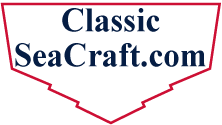
 |
|
|
|
#1
|
|||
|
|||
|
Terry, I think the USCG didn't require blowers till late 60's or early 70's. However there's no substitute for opening the engine box to give it the sniff and smell test - the owner of the UNOHU did that before EVERY engine start! One could also argue that in the case of a bad fuel leak where the mixture is too rich to ignite, a blower could make things worse by adding enough O2 to CREATE an explosive mixture! The sniff test is obviously preferred in that case!
That said, USCG probably had good reasons for adding the blower requirement, so think I'd add one anyway. You might also need it if you want to get the boat inspected for insurance purposes. I think I'd also add a fume detector, even before I added the blower, to cover the situation where a fuel leak develops underway, even though nothing was leaking at start-up! By the way, what venturi's are you talking about? Do you mean the inlet/outlet vent scoops that I think were on the transom cap? Denny
__________________
'72 SeaFari/150E-Tec/Hermco Bracket, owned since 1975. http://i188.photobucket.com/albums/z...Part2019-1.jpg |
|
#2
|
|||
|
|||
|
If your using the vents, be sure to have the front vents facing forward I see many Potter vented SC's that are facing stern. A big part of those vents is just the positive air flow through the bildge that keeps it dry. Outboard and especially Inboard.
__________________
Snookerd |
|
#3
|
|||
|
|||
|
Yes,you need to have a blower.It's a requirement on I/O powered boats.Even if it wasn't required,it would be foolish not to have one.
I run an I/O,on my current boat,and i always run the blower for about three of four minutes. Accidents can happen,in fuel systems,and gas vapors in bilges can make for one hell of an amusement ride,that won't return to the park once you turn the key and ignite them. My procedure is to run the blower,while we're getting the rods and tackle ready.After a minute or two,I stick my big nose near the vent that exhausts the air,and smell for any gas odors,if there's no smell,I'll fire up the engine. Any vents should be big enough to provide,enough fresh air in,to replace the air that's exhausted out by the blower.As Snookered mentioned,it's a good idea to have foward and rear facing vents to help force air in and out while underway. The blower should be mounted as low as possible in the bilge,as gas vapors settle,but it has to also stay dry.Hook up the outlet side of the blower to a flexible vent hose,and attach it to a rear facing vent to exhaust the vapors. Explosions from gasoline bilge vapors in boats are not uncommon,there are several of them every year. Last year i was launching my boat,and as my buddy was backing it down the ramp,the rear vent was about even with my face. All of a sudden i got a very strong smell of gasoline,from the vent.We ended up taking the boat back to the yard on the trailer,and when i opened the motor box cover,i found about a gallon of gasoline in the bilge. I take extremely good care of my mechanicals,but we found a tiny split in the fill hose way up out of site in the hull. I had filled up at a gas station just before we were going to launch. Needless to say,we didn't use the boat that day,we drained the gas out and washed out the bilge with detergent and lots of water.Installed a new fill hose,and all is ok. I would definitely install and use a blower,it's a wise decision. This is a picture of the bilge in my project Tsunami 23.You can see the blower in the front left corner on the engine bed.I have the silver exhaust hose on the blower, going to the starboard rear vent,and another vent hose from the port side to bring fresh air in.There are other intake vent hoses,that don't show in the picture. There are also port and starboard vents on the hull facing forward,that are about even with the front seats. They force fresh air into the hull. 
__________________
All this,just for a boat ride |
|
#4
|
|||
|
|||
|
The 21's never had the 4 plastic vents in the hull like the 23's have. They had 2 scoops on the transom cap just aft of the engine facing fore and aft, like the Moesly era Seafari's.
The Unohu also had scoops on rear sides of engine box, facing down towards transom waterline, that could be used as handles to open the box.
__________________
'72 SeaFari/150E-Tec/Hermco Bracket, owned since 1975. http://i188.photobucket.com/albums/z...Part2019-1.jpg |
 |
|
|